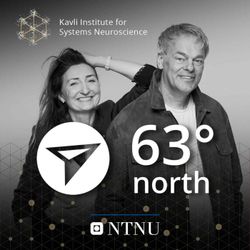Share

63 Degrees North
Old bones and modern germs
Trondheim, Norway’s first religious and national capital, has a rich history that has been revealed over decades of archaeological excavations. One question archaeologists are working on right now has a lot of relevance in during a pandemic: Can insight into the health conditions of the past shed light on pandemics in our own time? Now, with the help of old bones, latrine wastes and dental plaque, researchers are learning about how diseases evolved in medieval populations, and what society did to stem them — and how that might help us in the future.
Our guests for this episode were Axel Christophersen, a professor of historical archaeology at the NTNU University Museum; Tom Gilbert, a professor at the NTNU University Museum and head of the Center for Evolutionarly Hologenomics based at the University of Copenhagen; and Elisabeth Forrestad Swensen, a PhD candidate at the NTNU University Museum.
You can read more about the MedHeal research project on the project’s home page.
Here are some of the academic articles on medieval Trondheim related to the podcast:
Zhou Z, Lundstrøm I, Tran-Dien A, Duchêne S, Alikhan NF, Sergeant MJ, Langridge G, Fotakis AK, Nair S, Stenøien HK, Hamre SS, Casjens S, Christophersen A, Quince C, Thomson NR, Weill FX, Ho SYW, Gilbert MTP, Achtman M. Pan-genome Analysis of Ancient and Modern Salmonella enterica Demonstrates Genomic Stability of the Invasive Para C Lineage for Millennia. Curr Biol. 2018 Aug 6;28(15):2420-2428.
Stian Suppersberger Hamre, Valérie Daux- Stable oxygen isotope evidence for mobility in medieval and post-medieval Trondheim, Norway,
Journal of Archaeological Science: Reports, Vol. 8, 2016, pp 416-425,
A transcript of the show is available here.
More episodes
View all episodes

28. Old flames die hard
21:19||Season 5, Ep. 28Jimmy Chaciga, a PhD research fellow at Makerere University in Uganda, thinks he has what it will take to get Ugandan households to adopt solar-powered cookers. First, cookers need to be simple to operate. They need to be cheap. They need to be able to cook once the sun has gone down.But most of all, they need to be able to cook beans."If you can cook beans, you can cook anything," he says.Armed with two drums, a lot of insulation, some solar panels and a dream, Chaciga is trying to bring his cooker to Ugandan households and institutions that need it the most.Chaciga is one of a group of African researchers working with NTNU's Ole Jørgen Nydal under projects funded by NORAD, the Norwegian Agency for International Development, and the University Network on PhD Programmes in Energy Technology (UNET), co-funded by the EU's Erasmus + programme.Here's the situation: After decades of research and funding to help households in developing countries shift away from firewood, charcoal and other biomass, 75% continue to rely on these resources for cooking. Clearly, cooking with wood is bad. It wastes women and children's time as they scavenge scarce wood to burn.It contributes to deforestation. It's a huge problem that seems like it should be solvable with enough smart engineering, yet it persists.Today's episode explores the successes and challenges researchers have faced in tackling this issue.My guests are Jimmy Chaciga, Ashmore Mawire and Ole Jørgen Nydal.You can see videos and documents from the International Energy Agency's Clean Cooking Summit from May 2024 here.Here are some publications describing some of the work in today's show:Chaciga, Jimmy; Nyeinga, Karidewa; Okello, Denis; Nydal, Ole Jørgen. (2024) Design and experimental analysis on a single tank energy storage system integrated with a cooking unit using funnel system. Journal of Energy StorageNydal, Ole Jørgen. (2023) Heat Storage for Cooking: A Discussion on Requirements and Concepts. EnergiesCooking with solar ovens in sub-Saharan Africa, Norwegian SciTech NewsHere are some background documents that describe the problem over time:Joseph Elasu, et al.(2023) Drivers of household transition to clean energy fuels: A systematic review of evidence,Renewable and Sustainable Energy Transition.World Bank. (2011). Household Cookstoves, Environment, Health, and Climate Change: A New Look at an Old Problem. Washington, DC: World Bank.Ideas? Feedback? Email me at nancy.bazilchuk@ntnu.no
27. From Running Rats to Brain Maps: A Nobel Odyssey
37:36||Season 4, Ep. 27When the phone rang 10 years ago while Norwegian neuroscientist May-Britt Moser was in a particularly engaging lab meeting, she almost didn't answer it.Good thing she did! It was Göran Hansson, secretary of the Nobel Committee for Physiology or Medicine, with the news: May-Britt Moser and Edvard Moser, along with their mentor and colleague John O’Keefe from the University College London, had just won the Nobel Prize in Physiology or Medicine for their discoveries of two types of brain cells that work together to function like a GPS in the brain.That system allows animals -including us - to know where they are, and navigate to where they want to go. This was a groundbreaking discovery because it gave us critical insight into how an area of the brain, far from the normal sensory inputs of sight, sound and touch, constructs its own way of understanding space. And, because this same area of the brain, and our ability to navigate, are affected early on in Alzheimer's patients, it offers an inroad for clinicians studying the disease. In fact, the KG Jebsen Centre for Alzheimer's Disease, a part of the Mosers' Kavli Institute, is working to bring these fundamental insights about the brain to clinical practice.This episode is a celebration of the 10th anniversary of the Nobel award.To make it, I cracked open a time capsule of sorts: When the Mosers first learned that they had won the scientific world's highest honour, I ran down to their lab and recorded everything! The files in this podcast are from that day and the heady days afterwards.My guests on today's episode are May-Britt Moser and Edvard Moser.You can also find lots more material, including videos, more popular science articles and background information on this webpage.
26. Cathedral at the end of the world
25:44||Season 4, Ep. 26Nobelmen and women, in fancy clothing and pearls – but with dragon wings and tails. A laughing man with a full head of curly hair. Lions biting the ears off a man whose mouth is full of writhing serpents. These may sound like a weird combination of a gothic novel and a nightmare, but they're something completely different – a description of some of the eerie and surprising sculptures in Nidaros Cathedral, the northernmost gothic cathedral in the world that's located in NTNU's hometown of Trondheim.But what were the messages that stonemasons and religious leaders were trying to send visitors to the cathedral – and how do we interpret these messages 800 years later?My guests on today's show are Øystein Ekroll, chief archaeologist and researcher at the Nidaros Cathedral Restoration Workshop and Margrete Syrstad Andås, an art historian and associate professor at NTNU's Department of Art and Media Studies.You can read more about the history of the cathedral in this article from Norwegian SciTech News: Thousand-year-old cathedral surrenders its secrets, stone by stoneØystein Ekroll has an article about the building history of the cathedral from 1030 to 1537 that you can find here.Øystein's PhD dissertation is available here: The Octagonal Shrine Chapel of St Olav at Nidaros CathedralØystein and Margrete have also edited a book about the cathedral:Andås, Margrete Syrstad, Øystein Ekroll Andreas Haug and Nils Holger Petersen, eds,The Medieval Cathedral of Trondheim: Architectural and Ritual Constructions in their European Context (Traditions and Transformations 3), Turnhout, Brepols, 2007Andås, Margrete Syrstad. “Art and Ritual in the Liminal Zone.” In he Medieval cathedral of Trondheim : architectural and ritual constructions in their European context. Eds. Margrete Syrstad Andås, Øystein Ekroll, Andreas Haug and Nils Holger Petersen. Turnhout 2007: 47–126.Andås, Margrete Syrstad. ”The Octagon Doorway: A Question of Purity and Danger?” In Ornament and Order. Essays on Viking and Northern Medieval Art for Signe Horn Fuglesang. Edited by Margrethe C.Stang and Kristin B. Aavitsland, 97-134. Trondheim: Tapir, 2008.Like what you're hearing? Leave a review, tell your friends, subscribe! And you can contact me, Nancy Bazilchuk, with feedback at nancy.bazilchuk@ntnu.no
25. ENCORE: Hermann Göring's Luftwaffe and the $6 billion deal
29:16||Season 4, Ep. 25This episode was originally aired on March 16, 2021. Norway doesn't seem like a natural place for the aluminium industry to blossom. But somehow, it did – due in part to the unlikely combination of WWII Germany, a modest English engineer who created a worker’s paradise, an ambitious industrialist prosecuted as a traitor and a hardworking PhD. All of these factors and personalities helped build modern Norway, one aluminium ingot at a time.Today's guests are Hans Otto Frøland, Svein Richard Brandtzæg and Randi Holmestad. Frøland is one of the researchers working in the Fate of Nations project, which is based at NTNU and focused on the global history and political economy of natural resources. To see archival photographs related to the episode, check out this companion article in Norwegian SciTech News.You can read more about the history of aluminium in Norway here:From Warfare to Welfare: Business-Government Relations in the Aluminium Industry (2012) Frøland, Hans Otto; Ingulstad, MatsAkademika ForlagFrøland, Hans Otto; Kobberrød, Jan Thomas. (2009) The Norwegian Contribution to Göring's Megalomania. Norway's Aluminium Industry during World War II. Cahiers d'histoire de l'aluminium. vol. 42-43.Frøland, Hans Otto. (2007) The Norwegian Aluminium Expansion Program in the Context of European integration, 1955-1975. Cahiers d'histoire de l'aluminium.Gendron, Robin S.; Ingulstad, Mats; Storli, Espen. (2013) Aluminum Ore: The Political Economy of the Global Bauxite Industry. University of British Columbia Press. 2013. ISBN 978-0-7748-2533-7.Like the show? Have questions? Contact me, Nancy Bazilchuk, at nancy.bazilchuk@ntnu.noYou can find the transcript for the show here.
24. ENCORE: Old bones and modern germs
26:24||Season 4, Ep. 24This episode originally aired on Feb. 16, 2022.Trondheim, Norway’s first religious and national capital, has a rich history that has been revealed over decades of archaeological excavations. One question archaeologists are working on right now has a lot of relevance in a pandemic: Can insight into the health conditions of the past shed light on pandemics in our own time? Now, with the help of old bones and dental plaque, researchers are learning about how diseases evolved in medieval populations, and what society did to stem them — and how that might help us in the future.Our guests for this episode were Axel Christophersen, a professor of historical archaeology at the NTNU University Museum; Tom Gilbert, a professor at the NTNU University Museum and head of the Center for Evolutionarly Hologenomics based at the University of Copenhagen; and Elisabeth Forrestad Swensen, a PhD candidate at the NTNU University Museum.You can read more about the MedHeal research project on the project’s home page.Here are some of the academic articles on medieval Trondheim related to the podcast: Zhou Z, Lundstrøm I, Tran-Dien A, Duchêne S, Alikhan NF, Sergeant MJ, Langridge G, Fotakis AK, Nair S, Stenøien HK, Hamre SS, Casjens S, Christophersen A, Quince C, Thomson NR, Weill FX, Ho SYW, Gilbert MTP, Achtman M. Pan-genome Analysis of Ancient and Modern Salmonella enterica Demonstrates Genomic Stability of the Invasive Para C Lineage for Millennia. Curr Biol. 2018 Aug 6;28(15):2420-2428.Stian Suppersberger Hamre, Valérie Daux- Stable oxygen isotope evidence for mobility in medieval and post-medieval Trondheim, Norway,Journal of Archaeological Science: Reports, Vol. 8, 2016, pp 416-425, A transcript of the show is available here.
23. ENCORE: Shedding light on the polar night
24:53||Season 4, Ep. 23This episode originally aired on January 27, 2021.Krill eyeballs. The werewolf effect. Diel vertical migration. Arctic marine biologists really talk about these things. There’s a reason for that — when it comes to the polar night, when humans see only velvety darkness, krill eyeballs see things a little differently. And when the sun has been gone for months, during the darkest periods of the polar night, the moon does unexpected things to marine organisms. Learn more about what biologists are figuring out about the workings of the polar night — and what it means at a time when the Arctic is warming at a breakneck pace. Our guests for this episode were Jørgen Berge, Geir Johnsen, Laura Hobbs and Jonathan H. Cohen. You can see a transcript of the episode here. Fridtjof Nansen’s book about his Arctic expedition is called Farthest North. You can also read about the other influences his pioneering journey had on science here. You can also read about Geir Johnsen’s different research projects in a series of articles from Norwegian SciTech News. The findings of the polar night team are so surprising that they actually wrote a textbook about it, edited by Jørgen Berge, Geir Johnsen and Jonathan H. Cohen. The book is titled Polar Night Marine Ecology: Life and Light in the Dead of Night.Here are some of the polar night research articles:Berge, J., Renaud, P. E., Darnis, G. et al. (2015) In the dark: A review of ecosystem processes during the Arctic polar night. Progress in Oceanography, 139: 258-271 Ludvigsen, M., Berge, J., Geoffroy, M. et al. (2018) Use of an Autonomous Surface Vehicle reveals small-scale diel vertical migrations of zooplankton and susceptibility to light pollution under low solar irradiance. Science Advances 4: eaap9887 Hobbs L, Cottier FR, Last KS, Berge J (2018) Pan-Arctic diel vertical migration during the polar night. Mar Ecol Prog Ser 605:61-72. Berge, Jørgen; Geoffroy, Maxime; Daase, Malin; Cottier, et al.(2020) Artificial light during the polar night disrupts Arctic fish and zooplankton behavior down to 200 m depth. Communications Biology. 3 (102), 10.1038/s42003-020-0807-6
22. Strange bedfellows: Howard Hughes, a $2 billion ship and a lost Soviet submarine
18:52||Season 4, Ep. 22It's 1968 and a Soviet sub carrying nuclear warheads has gone missing – lost, with all hands. The Soviets never found it – but the Americans did – in nearly 5000 meters of water.What follows is the strange tale of Project Azorian, an ultra-secret mission by the US Central Intelligence Agency, the CIA, that played on national fervor over deep sea mining to create an elaborate cover story to raise the sub. This strange tale involved Howard Hughes, a journey around the tip of South America, the 1973 Chilean coup and a 1974 burglary. This last resulted in an expose of what has been called one of the greatest covert operations in the CIA's history.I stumbled onto this story in the course of reporting the episode on Norway's decision to open its seabed to exploration and mining, and couldn't resist making a little podcast extra about it since it's such a bizarre tale. Fortunately, my guest on today's show, Mats Ingulstad, a professor at NTNU's Department of Modern History and Society, was equally fascinated by this little sidebar to the history of deep sea mining, so here you have it.Here are some links to relevant documents:The declassified CIA document (heavily excised) about Project Azorian, with lots of amazing detailsThe US National Security Archive's webpage describing the declassification of the CIA's Project AzorianThe US Department of State, Office of the Historian's extremely detailed description of The Hughes Glomar Explorer’s Secret Mission to Recover a Sunken Soviet SubmarineFor the definitive account of the whole affair, check out the book Project Azorian: The CIA and the Raising of the K-129.A New York Times article about the 1974 burglary that first exposed Project Azorian: https://www.nytimes.com/1975/03/27/archives/an-easy-burglary-led-to-the-disclosure-of-hughescia-plan-to-salvage.htmlThe Wikipedia page on Project AzorianThe Kennedy speech came from a 28-minute film made on behalf of the US Air Force, called Oceanography: Science for Survival. It's available from the John F. Kennedy Presidential Library and Museum.I don't talk about it, but the part of the sub that was raised also contained the bodies of six submariners, who were subsequently given a proper burial at sea. There's a video of the ceremony here.If you've read this far, I'd be interested in feedback on the sound design of this podcast. I had access to a different music library and decided to use a lot of music to see how it would sound. So let me know: was it too loud, too much, not enough? If you do send a note, make sure to tell me what kind of headphones you're using. Other comments? Questions? Fan mail? email me at nancy.bazilchuk@ntnu.no
21. Seabed mining – savior or scourge?
28:15||Season 4, Ep. 21Norway's Mid-Arctic Ocean Ridge is alive with underwater volcanic activity – where big towers called black smokers spew mineral-laden boiling hot water into the ocean. The minerals precipitate out, and have accumulated over millions of years. At the same time, this extreme environment is home to lots of weird creatures mostly unknown to science. This week, a look at the pros and cons of Norway's decision to open an area the size of Italy to extract minerals. Today's guests are Mats Ingulstad, Egil Tjåland, Kurt Aasly and Torkild Bakken.Here are links to some of the articles and opinion pieces mentioned in the show:Norway needs to know much more before actually mining the deep sea Opinion piece written by Mats Ingulstad and his colleagues at Triple Deep, first published Dagens Næringsliv, a national newspaper.This link takes you to the 17 Jan. EU Parliament hearing on Norway's decision.Norway will be the first in the world to approve seabed mining. Is it a good idea? A piece from Norwegian SciTech News with a roundup of coverage on seabed mining.A report summary from Rystad Energy, commissioned in part by the Norwegian Forum for Marine Minerals, which estimates the economic potential of the seabed minerals in the area opened by the Norwegian government.The European Academies' Science Advisory Council report assessing future needs and environmental impacts of deep sea mining. This editorial from the academic journal Nature argues that Norway's decision undermines efforts to protect the ocean.The scientific article about new species discovered around Loki's Castle: Eilertsen, Mari Heggernes; Kongsrud, Jon Anders; Tandberg, Anne Helene S.; Alvestad, Tom; Budaeva, Nataliya; Martell, Luis. (2024) Diversity, habitat endemicity and trophic ecology of the fauna of Loki’s Castle vent field on the Arctic Mid-Ocean Ridge.Here's a link to the press release from the University of Bergen on the discovery of Loki's Castle.Find the transcript here
20. Report from Dubai
12:38||Season 3, Ep. 20Our guest on today's show is Anders Hammer Strømman, one of the lead authors for the last Intergovernmental Panel on Climate Change report on mitigation of climate change, released in April 2022. He was invited to Dubai to the COP 28 climate talks to talk to the shipping industry about how they can reduce their greenhouse gas emissions. He also shares his experience – not from the negotiating rooms – but from the perspective of a scientist seeing his work being taken up by policy makers.Here's a link to the IPCC report for which Anders was one of the lead authors:https://www.ipcc.ch/report/ar6/wg3/chapter/chapter-10/You can read more about other NTNU researchers, including Helene Muri and Edgar Hertwich, who participated in the conference here:https://norwegianscitechnews.com/2023/12/climate-talks-and-the-way-forward/https://norwegianscitechnews.com/2023/12/the-energy-footprint-of-architecture-built-by-oil/https://norwegianscitechnews.com/2021/09/blocking-the-sun-to-control-global-warming/